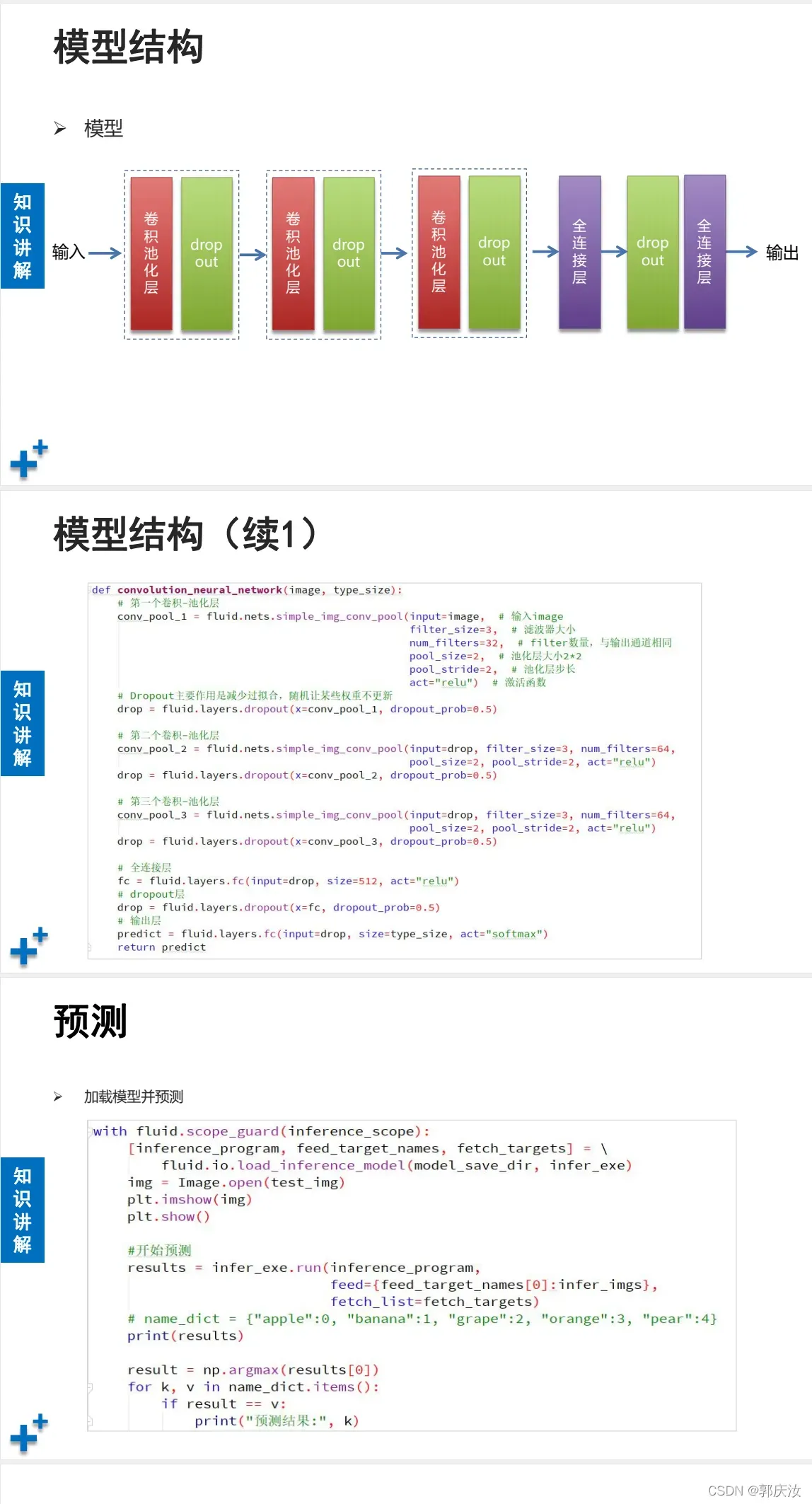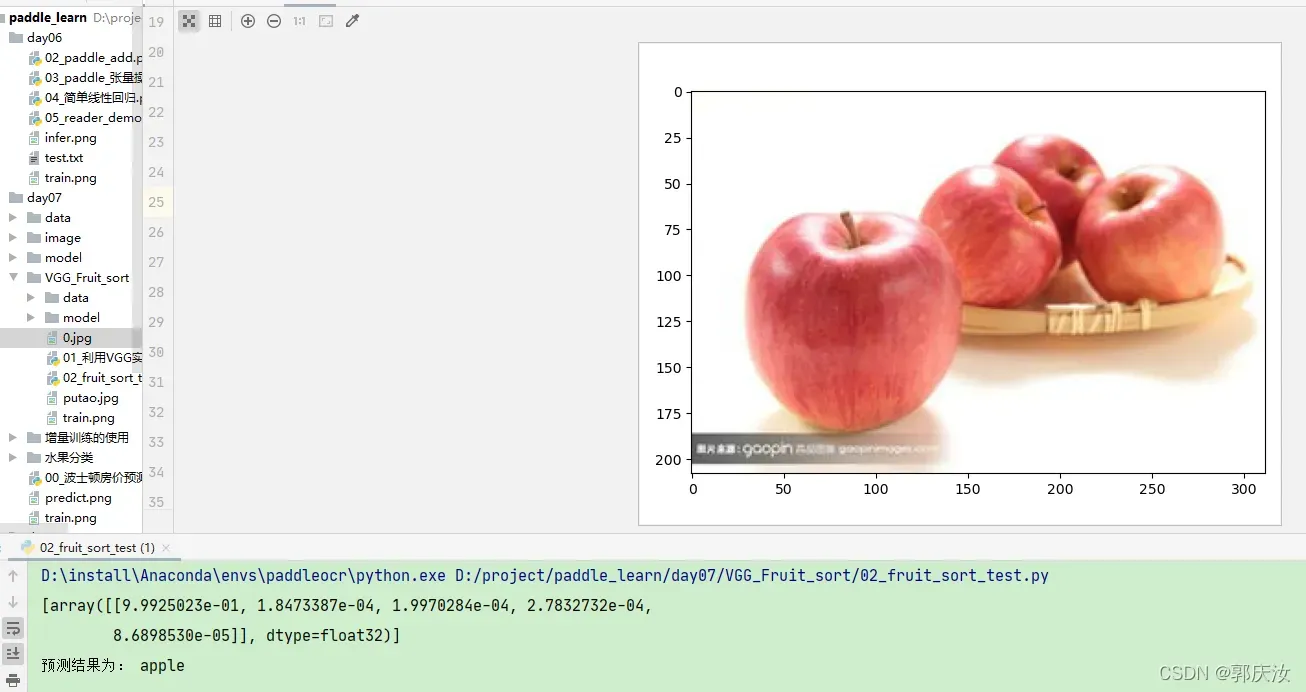1、基本用法

2、训练水果分类模型

1、数据集预处理与模型定义代码:
import os
###################################第一部分:水果预处理部分#################################
# 定义一组变量
name_dict = {"apple": 0, "banana": 1, "grape": 2, "orange": 3, "pear": 4} # 水果名称和数组对应字典
data_root_path = "data/fruits/" # 数据样本所在目录
test_file_path = data_root_path + "test.txt" # 测试集文件路径
train_file_path = data_root_path + "train.txt" # 训练集文件路径
name_data_list = {} # 记录每个类别的图片路径
# 将文件路径存入临时字典
def save_train_test_file(path, name):
if name not in name_data_list: # 当前水果没有在字典中,新增
img_list = []
img_list.append(path) # 将图片添加到列表
name_data_list[name] = img_list # 将“名称-图片列表”键值对插入字典
else: # 当前水果已经在字典中,添加到相应的列表
name_data_list[name].append(path)
# 遍历所有子目录,读取出所有图片文件,并插入字典、保存到测试集、训练集
dirs = os.listdir(data_root_path)
for d in dirs:
full_path = data_root_path + d # 目录名称 + 子目录名称
if os.path.isdir(full_path): # 目录
imgs = os.listdir(full_path) # 列出子目录中的文件
for img in imgs:
save_train_test_file(full_path + "/" + img, # 图片文件完整路径
d) # 子目录名称(类别名称)
else: # 文件
pass
# 将字典中的内容保存文件中
with open(test_file_path, "w") as f: # 清空测试集文件
pass
with open(train_file_path, "w") as f: # 清空训练集文件
pass
# 遍历字典,将内容写入文件
for name, img_list in name_data_list.items():
i = 0
num = len(img_list) # 每个类别图片数量
print("%s: %d张图像" % (name, num))
for img in img_list: # 遍历每个列表,将图片路径存入文件
if i % 10 == 0: # 每10张写一张到测试集
with open(test_file_path, "a") as f:
line = "%s\t%d\n" % (img, name_dict[name])
f.write(line) # 写入文件
else: # 其它写入训练集
with open(train_file_path, "a") as f:
line = "%s\t%d\n" % (img, name_dict[name])
f.write(line) # 写入文件
i += 1
print("数据预处理完成.")
###################################第二部分:水果预处理部分################################
import paddle
import paddle.fluid as fluid
import numpy as np
import sys
import os
from multiprocessing import cpu_count
import matplotlib.pyplot as plt
# 数据准备
## 定义reader
## train_mapper函数:对传入的图片路径进行读取,返回图像数据(多通道矩阵)、标签
def train_mapper(sample):
img, label = sample # 将sample中值赋给img, label
if not os.path.exists(img):
print(img, "图片文件不存在")
# 读取图片文件
img = paddle.dataset.image.load_image(img) # 读取图片
# 对图像进行简单变换:修剪、设置大小,输出(3, 100, 100)张量
img = paddle.dataset.image.simple_transform(im=img, # 原图像数据
resize_size=100, # 重设图像大小为100*100
crop_size=100, # 裁剪成100*100
is_color=True, # 彩色图像
is_train=True) # 是否用于训练,影响裁剪策略
# 对图像数据进行归一化处理,像素的值全部计算压缩到0~1之间
img = img.astype("float32") / 255.0
return img, label # 返回图像数据、标签
# 读取训练集文件,将路径、标签作为参数调用train_mapper函数
def train_r(train_list, buffered_size=1024):
def reader():
with open(train_list, "r") as f: # 打开训练集
lines = [line.strip() for line in f] # 读取出所有样本行
for line in lines:
# 去掉每行的换行符,并根据tab字符进行拆分,得到两个字段
img_path, lab = line.replace("\n", "").split("\t")
yield img_path, int(lab)
# xmap_readers高阶函数,作用是将reader产生的数据穿个train_mapper函数进行下一步处理
return paddle.reader.xmap_readers(train_mapper, # 二次处理函数
reader, # 原始reader
cpu_count(), # 线程数(和cpu数量一致)
buffered_size) # 缓冲区大小
BATCH_SIZE = 32 # 批次大小
# 定义reader
train_reader = train_r(train_list=train_file_path)# train_file_path为训练集文件路径
random_train_reader = paddle.reader.shuffle(reader=train_reader, # 原始reader
buf_size=1300) # 缓冲区大小
batch_train_reader = paddle.batch(random_train_reader,
batch_size=BATCH_SIZE) # 批量读取器
# 定义变量
image = fluid.layers.data(name="image", shape=[3, 100, 100], dtype="float32")
label = fluid.layers.data(name="label", shape=[1], dtype="int64")
# 创建VGG模型
def vgg_bn_drop(image, type_size): # 其包含批归一化层与丢弃层
def conv_bn_block(ipt, num_filter, groups, dropout):
# 创建Convolution2d,BatchNorm,Dropout,Pool2d组
return fluid.nets.img_conv_group(input=ipt, # 输入图像数据,【N,C,H,W】格式
pool_stride=2, # 池化步长值
pool_size=2, # 池化区域大小
conv_num_filter=[num_filter] * groups, # 卷积核的数量(即组的数量*每一组卷积核的数量)
conv_filter_size=3, # 卷积核大小
conv_act="relu", # 激活函数
conv_with_batchnorm=True, # 即卷积完成后是否要进行批量归一化操作
pool_type="max" # 池化的类型
)
# VGG前面的5组卷积池化
conv1 = conv_bn_block(image, 64, 2, [0.0, 0.0]) # 表示卷积核数量;2表示组数;[0.0,0.0]表示每组卷积的丢弃率
conv2 = conv_bn_block(conv1, 128, 2, [0.0, 0.0])
conv3 = conv_bn_block(conv2, 256, 3, [0.0, 0.0, 0.0])
conv4 = conv_bn_block(conv3, 512, 3, [0.0, 0.0, 0.0])
conv5 = conv_bn_block(conv4, 512, 3, [0.0, 0.0, 0.0])
drop = fluid.layers.dropout(x=conv5, dropout_prob=0.2)
fc1 = fluid.layers.fc(input=drop, size=512, act=None)
bn = fluid.layers.batch_norm(input=fc1, act="relu")
drop2 = fluid.layers.dropout(x=bn, dropout_prob=0.0)
fc2 = fluid.layers.fc(input=drop2, size=512, act=None)
predict = fluid.layers.fc(input=fc2,
size=type_size,
act="softmax")
return predict
# 调用上面的函数创建VGG
predict = vgg_bn_drop(image=image, type_size=5) # type_size和水果类别一致
# 损失函数
cost = fluid.layers.cross_entropy(input=predict, # 预测值
label=label) # 真实值
avg_cost = fluid.layers.mean(cost)
# 计算准确率
accuracy = fluid.layers.accuracy(input=predict, # 预测值
label=label) # 真实值
# 优化器
optimizer = fluid.optimizer.Adam(learning_rate=0.00001) # 自适应梯度下降优化器
optimizer.minimize(avg_cost)
# 创建Executor
place = fluid.CUDAPlace(0) # GPU上执行
exe = fluid.Executor(place) # 执行器
exe.run(fluid.default_startup_program()) # 初始化变量
# 定义feeder
feeder = fluid.DataFeeder(feed_list=[image, label], place=place)
costs = [] # 记录损失值
accs = [] # 记录准确率
times = 0
batches = [] # 记录批次
for pass_id in range(15):
train_cost = 0
for batch_id, data in enumerate(batch_train_reader()):
times += 1
train_cost, train_acc = exe.run(program=fluid.default_main_program(),
feed=feeder.feed(data), # 喂入一个batch数据
fetch_list=[avg_cost, accuracy]) # 获取结果
if batch_id % 20 == 0:
print("pass_id:%d, bat_id:%d, cost:%f, acc:%f" %
(pass_id, batch_id, train_cost[0], train_acc[0]))
accs.append(train_acc[0]) # 记录准确率
costs.append(train_cost[0]) # 记录损失值
batches.append(times) # 记录训练批次数
# 保存模型
model_save_dir = "model/fruits/" # 模型保存路径
if not os.path.exists(model_save_dir): # 如果模型路径不存在则创建
os.makedirs(model_save_dir)
fluid.io.save_inference_model(dirname=model_save_dir, # 保存路径
feeded_var_names=["image"], # 使用模型需传入的参数
target_vars=[predict], # 模型结果
executor=exe) # 模型
print("模型保存完成.")
# 训练过程可视化
plt.figure('training', facecolor='lightgray')
plt.title("training", fontsize=24)
plt.xlabel("iter", fontsize=20)
plt.ylabel("cost/acc", fontsize=20)
plt.plot(batches, costs, color='red', label="Training Cost")
plt.plot(batches, accs, color='green', label="Training Acc")
plt.legend()
plt.grid()
plt.savefig("train.png")
plt.show()

2、加载模型,预测图像
############################# 第三部分:加载模型,使用模型执行预测 ################################
from PIL import Image
import paddle.fluid as fluid
import paddle
import numpy
import matplotlib.pyplot as plt
def load_img(path): # 从指定路径读取图片数据
img = paddle.dataset.image.load_and_transform(
path, # 图片路径
100, 100, # resize图像大小、裁剪大小
False # 是否用于训练
)
# 因为需要对图像进行归一化,所以需要将图像转变为float32的格式
img = (img.astype("float32")) / 255.0 # 进行归一化
return img
# 定义执行器
place = fluid.CPUPlace() # 在预测时,计算量不大,所以没有必要在cuda上计算
infer_exe = fluid.Executor(place) # 创建执行器
model_save_dir= "model/fruits/" # 模型的保存路径
infer_imgs = [] # 用来存放待预测图像数据
test_img = "putao.png" # 待预测图片路径
infer_imgs.append(load_img(test_img)) # 读取图像数据,添加到待预测的列表中
# 因为神经网络无法读取列表数据,所以需要将列表数据转换为数组数据输入神经网络
infer_imgs = numpy.array(infer_imgs) # 转换为数组
# 加载保存的模型
infer_program,feed_target_names,fetch_targets= \
fluid.io.load_inference_model(model_save_dir, # 模型保存路径
infer_exe) # 要执行模型的Executor
# 使用模型执行预测
result = infer_exe.run(
infer_program, # 预测的program
feed={feed_target_names[0]: infer_imgs}, # 喂入待预测的数据
fetch_list=fetch_targets # 取得操作结果并返回
)
print(result) # 得到的result是一个各个分类概率的二维数组
"""
[array([[9.9999964e-01, 5.7820136e-24, 2.9262706e-10, 3.9078353e-07,1.4152669e-19]], dtype=float32)]
"""
index=numpy.argmax(result[0])
name_dict = {"apple": 0, "banana": 1, "grape": 2, "orange": 3, "pear": 4}
# 遍历字典
for k,v in name_dict.items(): # 对分类字典进行迭代返回的是字典的键,值
if index==v:
print("预测结果为:",k)
# 显示待预测的图片
img = Image.open(test_img)
plt.imshow(img)
plt.show()

文章出处登录后可见!
已经登录?立即刷新
